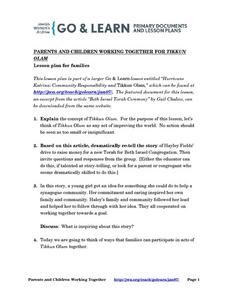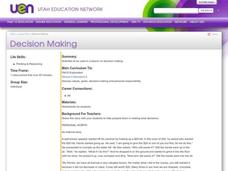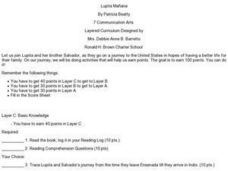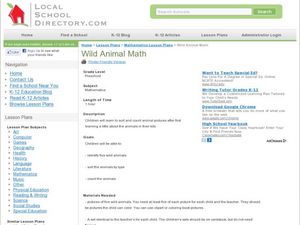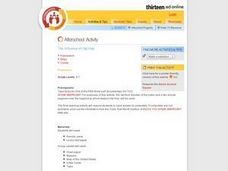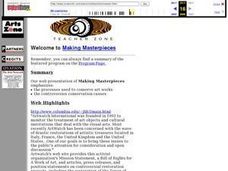Curated OER
Dreams
Young scholars read poetry about dreams and determine the different types of dreams people have, such as the images in sleep, or as goals.
Curated OER
Parents and Children Working Together for Tikkun Olam
Students explore the concept of Tikkun Olam as a way of improving their world. They listen to the story of Hayley Fields' goal to raise money for a new Torah and discuss what inspires them about her story. After discussion, they...
Curated OER
Decision Making
Students discuss the importance of making decisions in their lives. In groups, they are given examples of different scenerios and make a decision based on the information. To end the lesson, they identify their values and goals and how...
Curated OER
Lupita Ma¿¿ana
Students join Lupita and her brother Salvador, as they go on a journey to the United States in hopes of having a better life for their family. On their journey, they are doing activities that help them earn points. The goal is to earn...
Curated OER
What is Economics?
Students define economics; Explain the importance and process of making economic choices and decisions; Identify the factors of Production; Determine the goal of entrepreneurship. Students identify and describe the difficulties...
Curated OER
Wild Animal Math
Students examine wild animals. In this sorting and counting lesson, students are introduced to animals by viewing pictures. Students discuss the sounds they make, where they live and what they eat. Students pretend to be the animals....
Curated OER
The Freedmen's Bureau Graphic Organizer
In this American History worksheet, 11th graders analyze the goals of the Freedmen's Bureau. Students list the wants of ex-slaves.
Curated OER
Adolf Hitler
Students explore facts about Hitler's life and the historical events that occurred in that time, his view of history, his theory of race and his political goals. They explore his use of anti-Semitism to advance his career and consolidate...
Curated OER
Adventures in Earth Day: Why Do We Care About Our Environment? - Biology Teaching Thesis
Students are introduced to Earth Day and the importance of this day. They make a collage, students can use articles, pictures, words, etc., in magazines or newspapers or online, that relate to Earth Day, the environment and environmental...
Curated OER
Family History Through Art
Learners discuss various ways families and communities pass down oral and visual art forms to younger generations. This multi-subject introductory activity prepares students to create a project about their own families.
Curated OER
October: Respect for Self and Others
Students realize their worth and dignity as human beings and account for their strengths as well as display their weaknesses. They display good manners and politeness, showing the respect for others as they would wish for themselves....
Curated OER
If It's to Be, It's Up to Me!
Eighth graders discuss the question: How does one become an effective decision-maker or problem solver in social situations? They are given three brief scenarios and after each one students are asked, "What would you do?" Students think...
Curated OER
Discovering New Units
Young scholars use Cuisenaire rods to explore common denominators. In this fractions lesson plan, students build Cuisenaire representations of fractions, then find their equivalent counterparts to find the common denominator.
Serendip
DNA Structure, Function and Replication
Before a cell replicates, its DNA must replicate. Take advantage of a hands-on guided lesson to teach budding scientists how this happens. Using a set of nucleotide cards, learners become the DNA and work to create matching strands...
Curated OER
Gas Law Investigation
Investigators collect the carbon dioxide produced when an antacid tablet is activated and identify what alteration produced the most gas. They also collect the gas in a buret in order to practice precision. Then they choose between two...
Curated OER
Measurement and Conversion of Units in a Recipe
In a cross-curricular measurement and literacy instructional activity, your class will identify and compare cooking measurement instruments. They read a recipe and sequence a set of similar instructions in which the steps have been mixed...
Curated OER
Stem Cell Differentiation Game
This carad activity helps students explore detailed facts and scientific procedures around the human body and its cells. In this stem cell lesson plan, students utilize different colored flash cards to represent different types of human...
Curated OER
Navigation Across the Seas
Students examine nautical navigation and discover the differences between nautical charts and other types of maps or charts. Students practice setting a course, taking a bearing, and dead reckoning. This gives students an example of...
Curated OER
The Influence of Hip Hop
Students consider the influence of Hip Hop on their own language use and various segments of American society; they reflect on and demonstrate their knowledge of Hip Hop vocabulary and its use.
Curated OER
Make a Mission
Students discuss the terms exploration and technology. They read about the MESSENGER, Mission to Mercury, and answer questions. Next, they design and plan the technology for a space mission using an online interactive activity.
Curated OER
Welcome to Making Masterpieces
High schoolers examine factors that affect conservation of art works after identifying the nine agents of deterioration. They study techniques and thought processes behind art conservation.
Curated OER
LP 6--8: Xenopus laevis (frog) Development for a 7th Grade Audience
Seventh graders view lab stations with Xenopus at different stages of development. They identify the life stage of the sample, as well as the previous and next stages. Students must explain their reason for selecting the specific stage.
Curated OER
The Good and Bad Bacteria
Students are able to name one kind of harmful bacteria and why it hurts us and also name one kind of helpful bacteria and how we use it. They describe the process of growing bacterial cultures in a lab. Students create a reasonable...
Curated OER
Genetics and DNA
Students describe the structure of DNA and its components and can comprehend that real DNA and its cartoon representation are very different. They are able to link DNA to genetic make-up.

